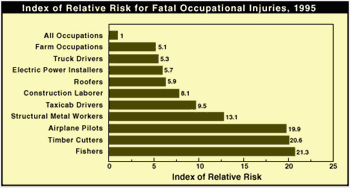|
Would you bet a month's spending money
on a spin of the roulette wheel? Would your lucky number be
the winner? The odds against your winning are 35 to 1. Not
interested? Maybe you'd rather go skydiving. You won't win
(or lose) any money, and the chances you'll become a fatal
statistic are only 1 in 57,000, a safer bet. And if you prepare
everything exactly as you should, jumping out of a plane and
hurtling 12,000 feet toward the ground at 120 miles per hour
should be a snap.
MANAGING RISK
Making all those precious preparations
is called "risk management." It's based on the premise
that even if we can't control the outcome of certain actions
or events, we can at least plan ahead as carefully as possible
to avoid potential pitfalls. The residual risk that remains
after all known associated hazards have been assessed and
accepted is called "acceptable risk."
DANGER: PEOPLE AT WORK
Some people take more than their
share of risks every day. According to the Bureau of Labor
Statistics, the group that holds down the most dangerous occupation
in the U.S. are fishermen (and women!), who are 21.3 times
more likely to have a fatal accident on the job than the average
worker. The next most dangerous job is timber cutter (at 20.6)
followed by airplane pilots (19.9).

THE RISKIEST JOB?
An occupation that doesn’t
even make the list of dangerous jobs, but which some people
consider the riskiest job of all, is astronaut. Besides the
obvious dangers inherent in being shot into space, there are
quite a few minor health risks that astronauts incur while
on the job:
- Living at zero gravity
can cause muscles to atrophy, disrupt blood circulation,
and make bones porous (which can also lead to tooth loss).
- Because astronauts take
in less fluid than the average person, they have a higher
risk of developing kidney stones.
- Then there's space junk,
the 10,000 or so large objects—everything from old
satellites to discarded fuel tanks—that pose the threat
of possible collisions with spacecraft—and spacewalkers.
This is not to mention all the tiny objects out there, which
can be just as dangerous.
THE NOT-SO-FRIENDLY SKIES
But perhaps the greatest health
danger an astronaut faces comes from the Sun. Astronauts working
outside a spacecraft—on the Moon, for example—during
a major solar particle event could receive a dose of 6 sieverts
(Sv) of radiation to the skin, equal to 600 rem, short for
"roentgen equivalent men." Rem are defined as the
dosage of any ionizing radiation that will cause the same
amount of biological injury to human tissue as one roentgen
of x-ray or gamma-ray dosage. That same solar event would
cause a bone marrow dose of close to 0.9 Sv (90 rem), something
like 500 to 1,000 times higher than the dose one receives
from a chest x-ray.
While the experts point out that such a high dose isn’t
life-threatening, they mention a variety of long- and short-term
consequences. A skin exposure of 6 Sv will, in about 50% of
cases, cause visible reddening, and an increased risk of skin
cancer in later years because of damage to the skin. It's
also likely that the astronaut would temporarily lose all
of his or her hair. Male astronauts would likely experience
temporary sterility (for 10-20 months). And it's generally
accepted that there is an increased risk of cancer as a result
of a whole-body radiation exposure of this intensity.
SAFE AT HOME?
For all you non-astronauts who think
you can hide from radiation by staying home, be advised that
all of us, indoors or out, receive about 300 mrem a year in
natural background radiation.
|